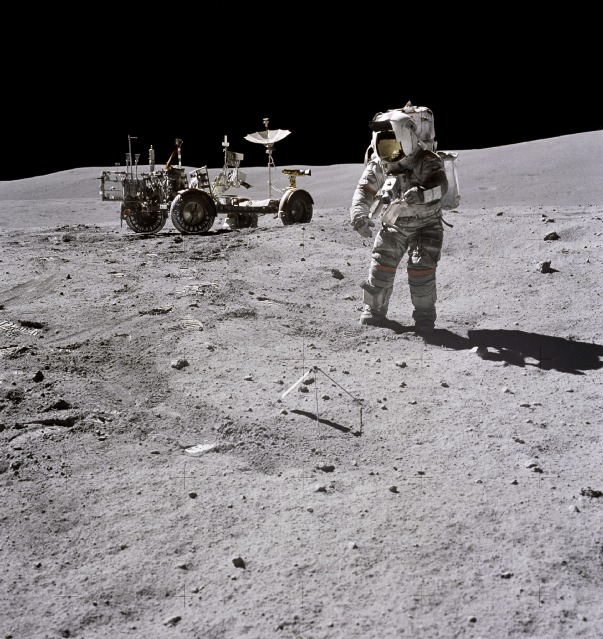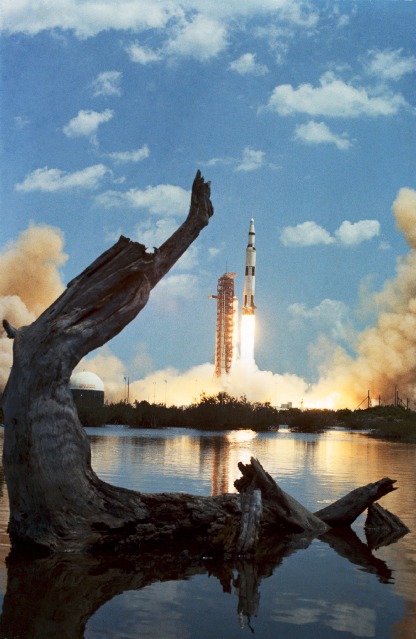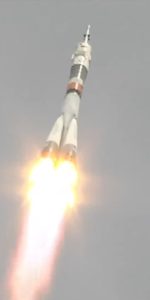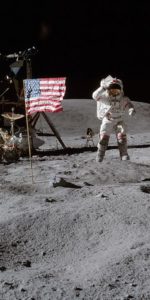
For anyone born within the last five decades, it is difficult to remember or understand a time when we were landing humans on the surface of the Moon. It is difficult to imagine that the technology was operationally available to deliver our kind across the 240,000-mile (370,000 km) gulf betwixt Earth and our closest celestial neighbor and achieved a controlled landing and on-foot scientific explorations of the hostile lunar terrain. Yet 45 years ago, this weekend, Apollo 16 Commander John Young and Lunar Module Pilot (LMP) Charlie Duke did just that, as their crewmate, Command Module Pilot (CMP) Ken Mattingly, orbited overhead. On 22 April 1972, Young and Duke wrapped up the second of their three Moonwalks at a mountainous place called Descartes.
It was a moment of triumph, indeed, for their mission came within a whisker of never landing on the Moon at all.
The early Apollo landings—by Neil Armstrong and Buzz Aldrin at the Sea of Tranquility in July 1969 and by Pete Conrad and Al Bean on the Ocean of Storms the following November—had made lunar landfall on flat mare regions. However, NASA later expanded its envelope and later crews touched down in the hummocky Fra Mauro foothills, the spectacular highland site of Hadley-Apennine and, for the program’s December 1972 grand finale, in the mountain-ringed Taurus-Littrow valley. In May 1971, less than a year before Apollo 16 was due to launch, the Site Selection Board picked a region of the Moon’s Cayley Plain, about 30 miles (50 km) south of the crater Descartes and a little to the west of Mare Nectaris (the Sea of Nectar).
It was hoped that this highland location would yield volcanic rocks and offer tantalizing insights into billions of years of the Moon’s evolution. So convinced were many in the geological community that Apollo 16 would find volcanic rocks at Descartes that most of the astronauts’ training was in volcanic regions on Earth.
The crew had an unlucky pedigree. Charlie Duke was the backup LMP for Apollo 13, but his infamous exposure to German measles led to a last-minute decision to ground Ken Mattingly from his spot as prime CMP on that crew. Mattingly was replaced by his own backup, Jack Swigert, and in March 1971 Young—as Apollo 13’s backup Commander—was assigned with the unfortunate duo to take Apollo 16 to the Moon. This led to an inevitable spot of banter on launch morning, 16 April 1972, particularly since the Apollo 16 backup Commander was actually Apollo 13 veteran Fred Haise.

“We were climbing into the Command Module on the launch pad,” Duke recalled in a NASA oral history. “I looked over and, taped to the back of my seat was a big tag that said Typhoid Mary!” Haise grinned. It was light-hearted payback, particularly as Duke had entered the headlines in January 1972, following a bout of bacterial pneumonia. Illness was never far away from Mattingly, either. Just before launch in April, doctors found an elevated level of bilirubin—a possible indicator of hepatitis—in one of his blood tests. “Billy who?” Mattingly snorted in disbelief. “Who’s he and what’s that?” His relationship with the doctors in the final days before Apollo 16 left Earth was, in Mattingly’s words, “about as antagonistic…as you could create”, but he was cleared to fly.
The mission launched from Pad 39A, atop the gigantic Saturn V, on the afternoon of 16 April 1972, kicking off a four-day voyage to the Moon. Late on the evening of the 19th, the Apollo 16 spacecraft—the Command and Service Module (CSM), named “Casper”, and the Lunar Module (LM), dubbed “Orion”—arrived smoothly in lunar orbit. Next morning, Young and Duke boarded Orion and undocked from Mattingly and Casper. They were in the process of running through checks of the lander, ahead of Powered Descent to the surface, when the situation turned ugly.
One of Mattingly’s tasks was to fire Casper’s Service Propulsion System (SPS) engine to adjust his orbital parameters from an ellipse into a near-circular path. This would enable him to undertake a three-day program of lunar science with a battery of instruments aboard the Scientific Instrument Module Bay (SIMBay) aboard the Service Module. In accordance with the plans, Mattingly routed power to the SPS, activated the gyros, prepared to test the secondary control system, then moved to touch the yaw thumb-wheel for the gimbal motors. All at once, Casper unexpectedly shuddered. It felt as if the CSM was heading down a very rough railroad track.
“I have an unstable yaw gimbal No. 2,” he radioed to Young and Duke.
“Oh, boy,” replied Young. He suggested a few corrective options, but was keenly aware that if the SPS control mechanism was damaged, it could spell the end of Apollo 16. There would be no landing on the Moon; only an ignominously premature return to Earth.
Mattingly knew that he could move the SPS nozzle, but was unsure if he could circularize his orbit with it. Mission rules dictated that all four thruster-vector-control circuits—primary and backup—had to be fully functional in order for a lunar landing attempt to be undertaken. There were few options. Casper and Orion were forced to fly in formation, and in limbo, as Mission Control pondered what to do. A redocking and a second attempt to land on 21 April was out of the question, because the Sun would have risen another 12 degrees in the lunar sky, making lightning conditions at the Descartes landing site unfavorable.
At length, consensus was reached. If Mattingly had to use the secondary system to make his circularization burn, the SPS might shudder, but would be controllable. Watching intently from Mission Control was former astronaut Jim McDivitt, in his new capacity as manager of the Apollo Spacecraft Program Office. He had tested the SPS during his command of Apollo 9 in March 1969 and had seen, first-hand, that it could stand up to duress.
Four hours after the trouble arose, at 7 p.m. EST on 20 April 1972, Capcom Jim Irwin radioed the crew to advise them that the landing attempt could go ahead.
What no one, save Mattingly, knew was that all of the SPS control signals—primary and backup—actually ran through the same cable. He had learned this fact during training, but had thought little of it. After Apollo 16 returned to Earth, he mentioned it to McDivitt. With a look of surprise on his face, McDivitt told Mattingly that if Mission Control had known about the cable, they would never have sanctioned the landing.
The second part of this article will appear tomorrow.
Be sure to “LIKE” AmericaSpace on Facebook and follow us on Instagram & Twitter!
Missions » Apollo »




